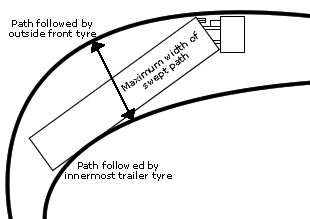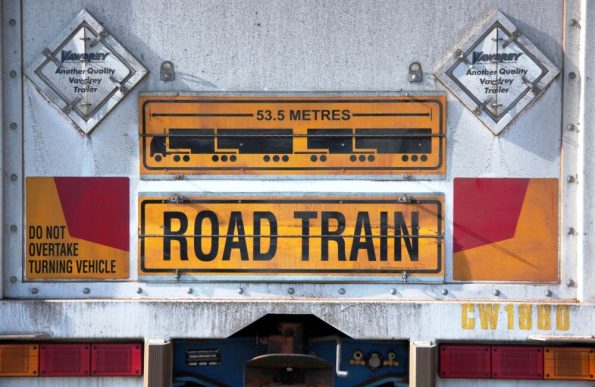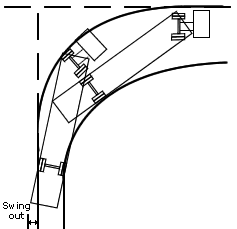What is the swept path?
Long vehicles have to move out wider to set the vehicle up for a turn because their rear wheels follow a path that forms a tighter circle than the front wheels. The area between the curve of the outer wheel and the curve of the inner wheel is called the swept path, as shown in this diagram.

Depending on how sharply the truck has to turn, it might need to move out a whole lane to make the left turn. This can catch drivers and cyclists out, and as the truck turns, they are left with no place to go. If the truck straddles the line then it’s easier to see its intention, but the motorist must be vigilant in observing the truck’s indicators.
Off-tracking at intersections and roundabouts
The path of the rear axle cuts the corner and this can cause problems for parked vehicles, street furniture and pedestrians.
![]()
This doesn’t only include t-intersections, driveways and crossroads, but also roundabouts. A truck going straight ahead or turning right may need to use two lanes, especially on mini-roundabouts.
Safety signage
Long vehicles that might need to make these types of turns have extra signage on the back to remind drivers.

Road train signage reminds people not to overtake when turning, and also of the total length of the vehicle for overtaking
Side underrun protection
For cyclists it can be especially dangerous as they can end up under the wheels of the truck. Long vehicles have blind spots that make it harder to see smaller road users like cyclists.
In London it is now a requirement for trucks to have barriers down the side of the trailers to help prevent this happening. This is called side underrun protection. The technical regulations for side underrun protection can be found here in UNECE Regulation 73. While it’s not mandatory in Australia, it is encourage and, in certain cases not only protects other road users but can also improve fuel economy.
Trailer swing out
If a trailer has a long overhang at the back, swing out can occur. This is where the back of the trailer follows a much wider arc than the wheels.

Cars and long trailers
While a car towing a short trailer is unlikely to have to make a significantly wider turn, a car towing a long caravan might need to. Drivers of heavy vehicles are trained how to position their vehicle to signal that they are turning, but drivers of cars towing long trailers don’t have this same training. Give plenty of warning with the indicator. Before making the manoeuvre, the driver must check in both mirrors to ensure that another road user hasn’t started an overtaking move.
